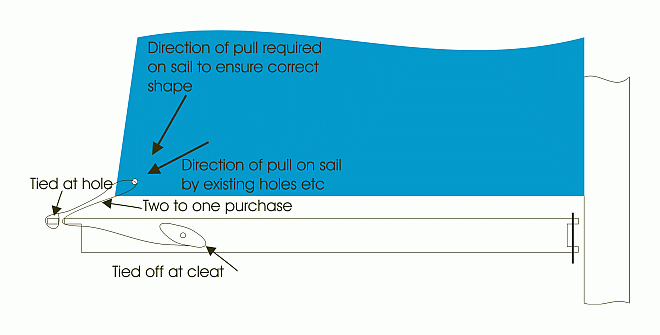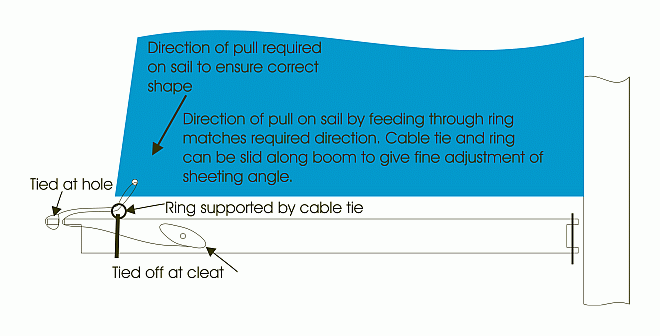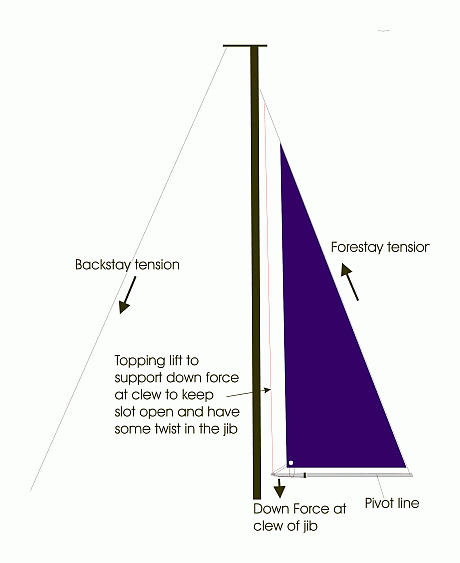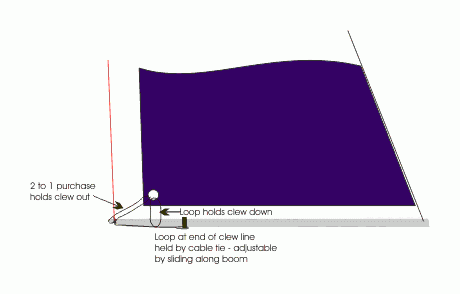Setting the Phantom Sails
Setting Phantom sails presents the same issues as setting other
flat panel sails and is little different from setting normal
panel sails with the added problem that all curvature of the
sail is supplied by the curve in the foot. In a flat panel
sail the curvature introduced this way will allow at least
2/3-3/4 of the sail to have some draught although the top
1/3-1/4 will still tend to fall off readily. In some ways
in a tender vessel like the Phantom, this may not be too much of
a disadvantage as the heeling forces generated by the top
section of the sail will be small and like wings in model
aircraft represent 'washout' and helps prevent the top of the
sail from stalling and reducing drag associated with it.
It may well be worth your while referring to the Sail
Modification section to see if your set of sails will set
properly anyway before you go to the trouble of rigging them on
the spars. This presents the issue of a correct luff curve
on the sails - essential in a flat panel sail!
Additionally the mast join 3/4 of the way up the mast is
critical. Any slack at this joint will allow the top of
the mast to fall back when backstay tension is applied.
This critically affects any luff curve you may have in the sail
as it now has to match a mast with still more curve. Get
your mast straight and glue a strong joiner into the mast to
connect the two sections. A piece of timber trimmed to
shape or better still some a section of fibreglass etc is much
much better than the plastic joiner supplied. Don't get
any glue in the sail track though!! This was the
first thing to break on my boat. Thanks to Jordy and Doc
for reminding me of this issue.
Unfortunately the sail setting options supplied by Phantom leave
a lot to be desired. This article outlines one way to
ensure you get the best from your sails.
Mainsail:
The luff, tack and head fittings and attachment points are
fairly basic but work OK. It is the clew and fittings at
the end of the boom that causes the problem. Most yachts I
have seen just use a line from the hole in the end of the boom
fed through the clew and the sail, back through the hole and
onto the tie position. This has some good points and bad
points! The good is that fed this way, the clew of the
sail will be controlled by a 2:1 system which allows finer
tuning of the clew of the sail. The bad is that the angles
are all wrong! The sheeting angle is so low that the sail
foot is pulled tight leaving no shape or camber in the foot thus
no curve can be introduced to the sail above. Such a flat
sail will not generate any substantial lift when beating to windward
though it will work fine running and even reaching where an
airfoil shape is not quite as essential.

To get the clew sheeting angle correct and to make it adjustable, the
easiest fitting to use is a small ring - 5mm from a fishing shop
and a cable tie to secure it. Wrapped around the boom and
pulled tight with pliers will hold the ring in place and allow
both to be slid along the boom to give fine adjustment. The
sheeting line is fed through the ring as in the diagram below.

Really that's all there is to it. Adjusting the ring will
allow more or less camber in the foot. Adjusting the
tension in the clew line will adjust the amount of tension in the
leech hence the amount of twist in the mainsail.
You should be aiming for about 8-10% of camber at the foot as it
will decrease up the sail because its a flat sheet of sail
cloth. This corresponds to a depth of 25-35 mm of depth in
the foot - about 2 finger widths. Most sailors I
have seen have had a camber of 0%! No wonder the yachts
stagger to windward. This might seem like a fair bit of
camber in a sail so what about pointing? A sail with 10%
camber will not be able to point as high as one with say 6% but
the Phantom is heavy, has a small keel area and will make
excessive leeway if you try to point too high. Better to
free off a little, foot faster and get to windward quicker.
Jib:
The jib is sightly different because the main boom has a boom
vang to hold the boom down and tension in the clew line will
tension the leech as much as you wish as the boom cannot lift up
because the vang is holding it down. The problem is the
a little different in the jib boom. Because it is pivoted about 20%
of the foot length back from the tack, tension in the luff
generated by backstay tension causes the clew end of the boom to
forced down generating
tension in the leech of about 1/4 the tension in the luff. In light winds this will pull the leech
tight causing the leech to curl back, the gap between the jib
and the sail (the slot) to close, stalling the sail and reducing
drive. In stronger winds the force of the wind will lift
the boom and open the slot. This means some means of
supporting the boom in light winds is essential. The
normal method is to use a topping lift - a light line connecting
the clew end of the boom to the forestay attachment position on
the mast. An adjustable sliding latching device (a
bowsie) can control and adjust this lift to maintain the desired
slot in the lighter winds.
As in the main sail, the angle of the pull by the clew line must
be adjustable to get the correct angle. It is easier in
the jib as the downward force is already present so a simple
loop through the clew and around the boom will hold the clew of
the sail fixed in a horizontal direction while the normal clew
line can be used to hold the clew out towards the end of the
boom. These two forces act together to give the required
force on the clew. Once again the foot of the sail should
have an 8%-10% camber (25mm-30mm) to give the sail an airfoil
and generate drive into the wind.

If despite all this work the sails still do not set at all
nicely then you may need to look at the sail modifications and
check those luff curves again as this is critical to getting a
nicely shaped sail with an efficient airfoil.
Mainsheet and Jibsheet settings
Now that the sails set properly, its time to think about the
final settings of the main and jib sheets. As a guide, the
mainsail is set with the boom at about 5°
and the jib about 10° when the sails are pulled fully in.
For the main boom this represents when the end of the boom is
about 25mm -35mm from the centreline of the yacht and about 55mm
- 60mm for the jib boom (roughly pointing towards the shrouds).
If you try and pull them in any tighter than this then you may
point a little higher but leeway will increase as your speed
decreases.
This is relatively easy enough
to achieve by judicious adjustment of the sheets coming from the
winch. However a major problem arises when the sails are
let out. It is a good idea to have an adjustment mechanism
on the end of the sheets so they can be set accurately to that
point. I like to tie a small loop on the end of the sheet
after feeding it through the boom attachment point and then held
in place by a cable tie around the boom through the loop.
The cable tie is pulled tight enough to hold but still able to
be slid along the boom. Simple and easily adjusted.
If tie is too loose either replace it or add another.
As the wind increases, the
Phantom heels readily and develops excessive weather helm.
Increasing the sheeting angle of the main up to and even beyond
the 10 degrees may be necessary to maintain control. This means
the jib becomes the main driving force in these conditions
- time to change to a 'B' rig

page
last edited on
23/05/2024